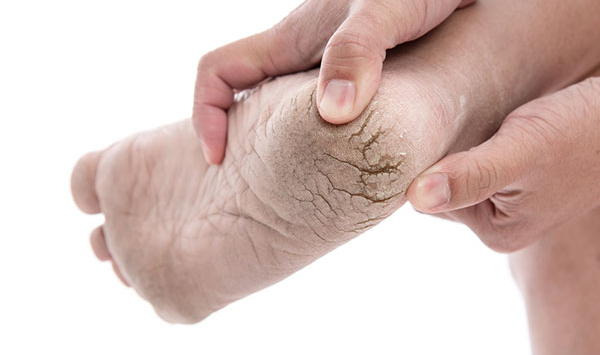Are you having trouble getting rid of your corns and calluses?
Corns and calluses are more than just an aesthetic nuisance and can be quite painful. Find out in this article how to get rid of them!
One of the most common complaints in podiatry offices is this: corns and calluses that refuse to stop appearing.
Do you know how corns and calluses are formed? If you are interested in finding out, and still find more treatment and prevention tips, read this article on the subject as well! Corns and Calluses: how corns on the feet form, types and prevention.
Next, we'll talk a little more about the different types of corns and calluses and how you can treat them! Check out:
What is the difference between corns and calluses?
Corns and calluses are thick layers of skin, usually caused by friction or pressure. Lesions stimulate defense responses in our body, which form skin accumulations to protect these areas.
Calluses often develop on the tops and sides of the feet and between the toes.
The main difference between calluses and calluses is that calluses have a defined region. Calluses, in turn, are more extensive.
The appearance of calluses is usually one of hardened lumps, protruding and surrounded by inflamed skin. They can hurt when pressed.
If you want to know more about the different types of corns and calluses, be sure to read our other article about it.
And why do corns hurt?
Pain in corns and calluses also happens due to friction and pressure. When pressing on the calluses, the deeper layers of skin feel the pressure as well. And these layers are full of nerve endings, which interpret this pressure as pain.
What are the most common causes for the appearance of corns and calluses?
Corns and calluses are a defense reaction of our body. That is, they appear to protect areas of the feet that are under frequent pressure or friction.
Thus, it is essential that a podiatrist make the proper diagnosis of the problem so that the treatment presents good results. The type of callus that has developed and the information about your feet can give the practitioner important clues about the cause of the problem. And, knowing it, it is possible to indicate an efficient treatment.
Check out some of the most common causes for the appearance of corns and calluses:
- tight shoes;
- Transverse arch collapse;
- Anatomy of the feet (toes overlapping);
- Incorrect posture;
- Wrong step;
- Sports like football and dancing.
Is it possible to prevent corns and calluses from appearing?
Yea! By acquiring healthy habits and taking proper care of your feet, you can prevent corns and calluses from forming.
Check out the following tips:
- Choose wider and rounded shoes;
- Choose shoes that absorb impact, relieving pressure on your feet;
- Moisturize the calluses for emollience as the calluses will be more flexible. This lessens the pain;
- If your foot is cracked, moisturize it before bed with an oil-based cream (they work deeper!). Your podiatrist can recommend an ideal cream for your case.
- Don't use kalicid: they're made from acid and can make the problem even worse - as well as causing some new ones. Kalicide is a medicine, and should only be used under medical advice. Never self-medicate!
- Do not file corns and calluses. This may appear to solve the problem, but sanding does not eliminate the cause. When the callus comes back - and it will - the formation process can be even worse.
How are the treatments for corns and calluses?
When calluses are already present, the most important point of treatment is to identify what caused the formation.
To smooth the appearance of corns and calluses themselves, some common procedures are:
- Manual removal: with PodoSafe®, which melts the most persistent and condensed calluses on the feet, without causing any discomfort, as it acts only on dead skin cells. It is a gentle, safe product that restores and rejuvenates your feet.
- Manual removal with sandpaper or pumice: usually done with sandpaper, pumice or similar, after softening the callus or callus with warm water.
- Keratolytics: these are acid-based substances, which should not be used without medical advice under any circumstances. This is because they can seriously damage the healthy skin area around the callus.
- Place cushions;
- Change the biomechanics of the feet;
Putting pads on and altering the biomechanics of the feet can prevent calluses. That's because these methods help to redistribute the pressure placed on your feet.
Patients with a tendency to calluses and calluses should be regularly attended to by podiatrists. Those with circulatory disorders, especially associated with diabetes, need a specialist.
Look for a professional to have the correct diagnosis, guidance and treatment
Among all the options for treating corns and calluses, you may notice that only manual removal can be performed at home. The problem with just using this method is that the corns and calluses will keep coming back. This is a way to treat symptoms without treating the cause.
A podiatrist, on the other hand, can perform more thorough examinations to understand the reasons for the formation of calluses and corns. Thus, you can use strategies that aim to directly address the cause.
And some tips you can do at home to keep your feet comfortable and healthy:
- Wear proper shoes of the right size;
- Choose comfortable shoes when spending a lot of time in them or walking a lot;
- Moisturize and relax your feet at the end of the day.
Make your appointment with us today and get rid of this hassle!






